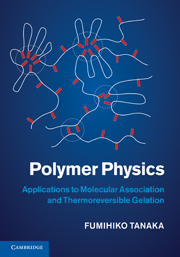Book contents
- Frontmatter
- Contents
- Preface
- 1 Statistical properties of polymer chains
- 2 Polymer solutions
- 3 Classical theory of gelation
- 4 Elasticity of polymer networks
- 5 Associating polymer solutions and thermoreversible gelation
- 6 Nongelling associating polymers
- 7 Thermoreversible gelation
- 8 Structure of polymer networks
- 9 Rheology of thermoreversible gels
- 10 Some important thermoreversible gels
- Index
- References
9 - Rheology of thermoreversible gels
Published online by Cambridge University Press: 16 May 2011
- Frontmatter
- Contents
- Preface
- 1 Statistical properties of polymer chains
- 2 Polymer solutions
- 3 Classical theory of gelation
- 4 Elasticity of polymer networks
- 5 Associating polymer solutions and thermoreversible gelation
- 6 Nongelling associating polymers
- 7 Thermoreversible gelation
- 8 Structure of polymer networks
- 9 Rheology of thermoreversible gels
- 10 Some important thermoreversible gels
- Index
- References
Summary
This chapter is devoted to the molecular rheology of transient networks made up of associating polymers in which the network junctions break and recombine. After an introduction to theoretical description of the model networks, the linear response of the network to oscillatory deformations is studied in detail. The analysis is then developed to the nonlinear regime. Stationary nonlinear viscosity, and first and second normal stresses, are calculated and compared with the experiments. The criterion for thickening and thinning of the flows is presented in terms of the molecular parameters. Transient flows such as nonlinear relaxation, start-up flow, etc., are studied within the same theoretical framework. Macroscopic properties such as strain hardening and stress overshoot are related to the tension–elongation curve of the constituent network polymers.
Networks with temporal junctions
In most polymer blends and solutions of practical interest, the polymer chains carry functional groups that interact with each other by associative forces capable of forming reversible bonds. These forces include hydrogen bonding, ionic association, stereo-complex formation, cross-linking by the crystalline segments, or solvent complexation. Because the bond energy is often comparable to the thermal energy, bond formation is reversible by a change in temperature or concentration.
- Type
- Chapter
- Information
- Polymer PhysicsApplications to Molecular Association and Thermoreversible Gelation, pp. 281 - 330Publisher: Cambridge University PressPrint publication year: 2011

